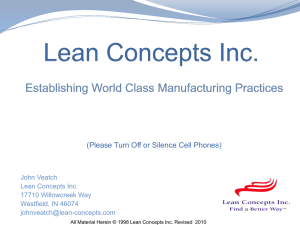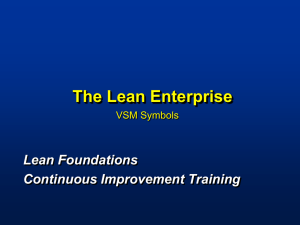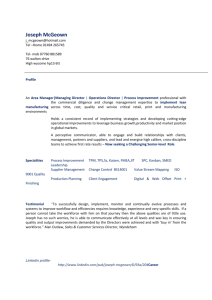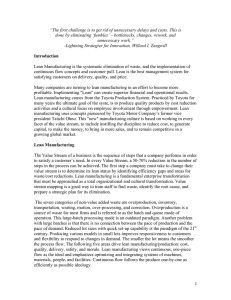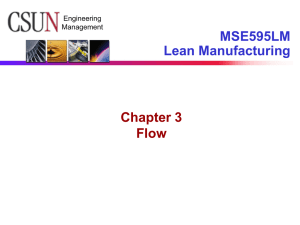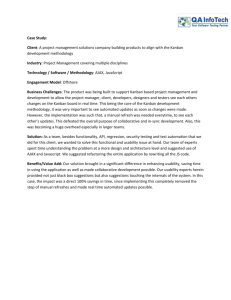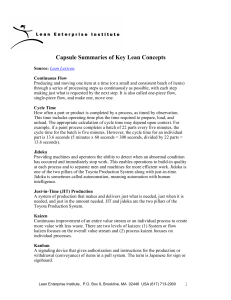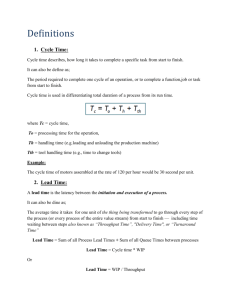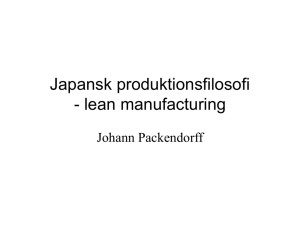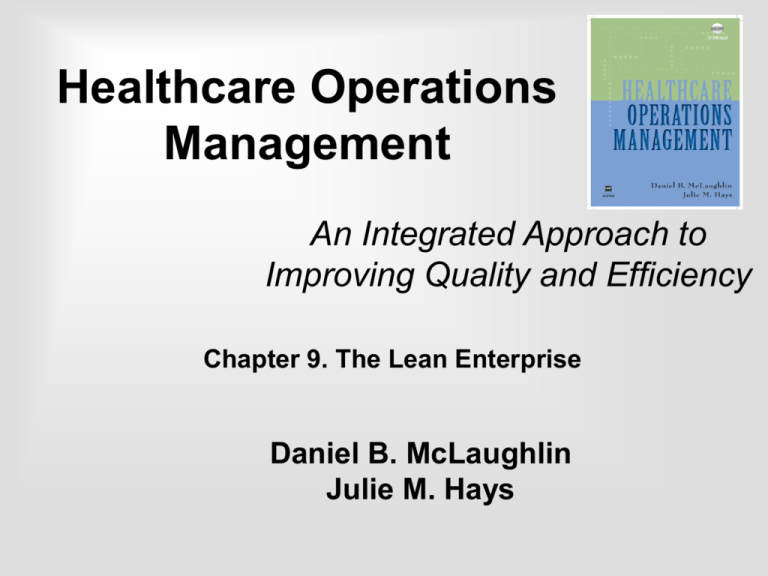
Healthcare Operations
Management
An Integrated Approach to
Improving Quality and Efficiency
Chapter 9. The Lean Enterprise
Daniel B. McLaughlin
Julie M. Hays
Chapter 9. The Lean Enterprise
•
•
•
•
•
Definition of Lean
Types of waste
Kaizen
Value stream mapping
Tools
- Takt time, throughput time, five Ss, spaghetti diagrams,
kaizen events, standardized work, jidoka, andon,
kanban, SMED, flow and pull, heijunka, advanced
access
• Lean Sigma
Copyright 2008 Health Administration Press. All rights reserved.
9-2
What Is Lean?
• Elimination of waste
- Toyota Production System (TPS)
• Philosophy
- Produce only what is needed, when it is
needed, with no waste
• Methodology
- Determination of value added in the process
• Tools
- Five Ss, kaizen event, standardized work, etc.
Copyright 2008 Health Administration Press. All rights reserved.
9-3
Types of Waste (Muda)
•
•
•
•
•
•
•
Overproduction
Waiting
Transportation
Inventory
Motion
Overprocessing
Defects
Copyright 2008 Health Administration Press. All rights reserved.
9-4
Kaizen Philosophy
• Employee-led continuous improvement
• Five steps
-
Specify value
Map and improve the value stream
Flow
Pull
Perfection
• Even if it isn’t broken, it can be improved.
Copyright 2008 Health Administration Press. All rights reserved.
9-5
Value Stream Mapping
• Process map of the value stream
• Includes information processing and
transformational processing
• Value-added steps: “Would the customer be
willing to pay for this activity?”
• Non-value-added steps
- Necessary
- Unnecessary
Copyright 2008 Health Administration Press. All rights reserved.
9-6
Value Stream Mapping
Nurses’ time spent on
non-patient care
Supplies
Housekeeping
Rooms
not available
Radiology
LOS
Lab
Long wait after
cleared to discharge
Pharmacy
Anesthesiology
Social
Services
Education
late
Slow
turnaround
Rooms
unavailable
Diagram created
with eVSM
software from
GumshoeKI, Inc.,
a Microsoft Visio
add-on.
Stabilize
Porter
Incorrect
patient forms
Patients
Admitting
Triage
0-2 hr
30-90 min
Labor
and
Delivery
1-3 hr
1-3 hr
Post
Partum
1-8 hr
1-60 hr
Copyright 2008 Health Administration Press. All rights reserved.
Discharge
1-5 hr
20-80 hr
3 hr
9-7
Tools
•
•
•
•
•
•
•
Takt time
Throughput time
Five Ss
Spaghetti diagram
Kaizen blitz or event
Jidoka
Andon
• Standardized work
• Kanban
• Single minute
exchange of die
(SMED)
• Flow
• Pull
• Heijunka
Copyright 2008 Health Administration Press. All rights reserved.
9-8
Takt Time
• The speed with which customers
must be served to satisfy demand for the service.
Available work time /day
Takt time
Customer demand/day
• Cycle time is the time to accomplish a task in the
system.
• System cycle time is equal to the longest task
cycle time in the system—the rate at which
customers or products exit the system, or
“drip time.”
Copyright 2008 Health Administration Press. All rights reserved.
9-9
Throughput Time
• Time for an item to complete the entire
process, which includes:
- Waiting time
- Transport time
- Actual processing time
Copyright 2008 Health Administration Press. All rights reserved.
9-10
Riverview Clinic
Cycle, Throughput, and Takt Time
Patient check-in
3 minutes
Move to examining room
2 minutes
Wait 15
minutes
Nurse does
preliminary exam
5 minutes
Physician exam
and consultation
20 minutes
Wait 15
minutes
Visit complete
Wait 10
minutes
Diagram created with eVSM software from
GumshoeKI, Inc., a Microsoft Visio add-on.
Copyright 2008 Health Administration Press. All rights reserved.
9-11
Riverview Clinic
Cycle, Throughput, and Takt Time
• Patient check-in cycle time = 3 minutes.
• System cycle time = cycle time for longest task =
physician exam and consultation = 20 minutes.
• Throughput time = 3 + 15 + 2 + 15 + 5 + 10 + 20 =
70 minutes.
• Takt time 8 physicians 5 hours/day
100 patients/day
0.4 physician hours/patient
24 physician minutes/patient.
Copyright 2008 Health Administration Press. All rights reserved.
9-12
Riverview Clinic
Value-Added Time
• Valued-added tasks:
- Nurse preliminary exam
- Physician exam and consultation
• Non-value-added steps, necessary:
- Patient check-in
• Value-added time = 5 minutes (nurse preliminary
exam) + 20 minutes (physician exam and
consultation) = 25 minutes.
• Percentage value-added time = 25 minutes/70
minutes = 35 percent.
Copyright 2008 Health Administration Press. All rights reserved.
9-13
Five Ss
• Seiri (Sort)—Separate necessary from
unnecessary items, including tools, parts,
materials, and paperwork, and remove the
unnecessary items.
• Seiton (Straighten)—Arrange the necessary
items neatly, providing visual cues to where
items should be placed.
• Seiso (Sweep)—Clean the work area.
• Seiketsu (Standardize)—Standardize the first
three Ss so that cleanliness is maintained.
• Shitsuke (Sustain)—Ensure that the first four
Ss continue to be performed on a regular basis.
Copyright 2008 Health Administration Press. All rights reserved.
9-14
Spaghetti Diagram
Copyright 2008 Health Administration Press. All rights reserved.
9-15
Kaizen Blitz or Event
•
•
•
•
•
•
•
•
Determine and define the objectives
Act
Determine the current state of the process
Determine the requirements of the process
Create a plan for implementation
Check
Implement the improvements
Check the effectiveness of the improvements
Document and standardize the improved process
Continue the cycle
Copyright 2008 Health Administration Press. All rights reserved.
Plan
Do
9-16
Results of 175 Rapid Process Improvement
Weeks at Virginia Mason Medical Center
Source: Womack, J. P., A. P. Byrne, O. J. Fiume, G. S. Kaplan, and J.Toussaint. 2005. "Going Lean in Healthcare."
Innovation Series white paper. Cambridge, MA: Institute for Healthcare Improvement. Online information available at:
http://www.ihi.org/IHI/Results/WhitePapers/GoingLeaninHealthCare.htm.
Copyright 2008 Health Administration Press. All rights reserved.
9-17
Standardized Work
• Written documentation of the way in which
each step in a process should be performed
• Not a rigid system of compliance, but a
means of communicating and codifying
current best practices
• Massachusetts General Hospital care paths
Copyright 2008 Health Administration Press. All rights reserved.
9-18
Jidoka and Andon
• Jidoka is the ability to stop the process
in the event of a problem.
- Prevents defects from passing from one
step in the system to the next
- Enables swift detection and correction of
errors
• Andon is a visual or audible
signaling device used to
indicate there is a problem in
the process.
Copyright 2008 Health Administration Press. All rights reserved.
9-19
Kanban
Empty
Kanban
Empty
Kanban
Full
Kanban
Task 1
Workstation
1
Full
Kanban
Task 2
Workstation
2
Customer
Order
Microsoft Visio® screen shots reprinted with permission from Microsoft Corporation.
Copyright 2008 Health Administration Press. All rights reserved.
9-20
Kanban
Signal
patients
Signal
echo
patients
CT
Microsoft Visio® screen shots reprinted with permission from Microsoft Corporation.
Copyright 2008 Health Administration Press. All rights reserved.
9-21
Single Minute Exchange of Die
(SMED)
• Used to reduce changeover or setup time,
which is the time needed between the
completion of one procedure and
the start of the next procedure
• Steps
- Separate internal activities from external
activities
- Convert internal setup activities to external
activities
- Streamline all setup activities
Copyright 2008 Health Administration Press. All rights reserved.
9-22
Flow and Pull
• Continuous or single piece flow—move items
(jobs, patients, products) through the steps of the
process one at a time without interuptions or
waiting.
• Pull or just-in-time (JIT)—products or services are
not produced until the downstream customer
demands them.
• Heijunka—“make flat and level”; eliminate
variation in volume and variety of “production”
- Level patient demand
Copyright 2008 Health Administration Press. All rights reserved.
9-23
Advanced Access
• Patients are unable to obtain timely primary
care appointments.
• Advanced access scheduling reduces the
time between scheduling an appointment for
care and the actual appointment.
• The goal is swift, even patient flow through
the system.
Copyright 2008 Health Administration Press. All rights reserved.
9-24
Advanced Access
Advantages
•
•
•
•
Decreases no-show rates
Improves patient satisfaction
Improves staff satisfaction
Increases revenue
- Higher patient volumes
- Increased staff and clinician productivity
• Promotes greater continuity of care
- Increased quality of care
- More positive outcomes for patients
Copyright 2008 Health Administration Press. All rights reserved.
9-25
Advanced Access
Implementation
• Advanced access challenges established
practices and beliefs.
• Balance supply and demand:
- Obtain accurate estimates of supply and
demand.
- Reduce or eliminate backlog.
- Minimize the variety of appointment types.
- May need to:
• Adjust demand profiles.
• Increase availability of bottleneck resources.
Copyright 2008 Health Administration Press. All rights reserved.
9-26
Lean Sigma
Lean and Six Sigma are focused on
continuous improvement of the
system.
Lean
Eliminate waste
• Achieve flow
and pull
Six Sigma
Eliminate defects
• Reduce
variation in
processes
Copyright 2008 Health Administration Press. All rights reserved.
6
9-27

